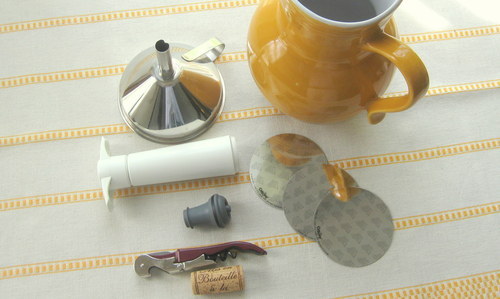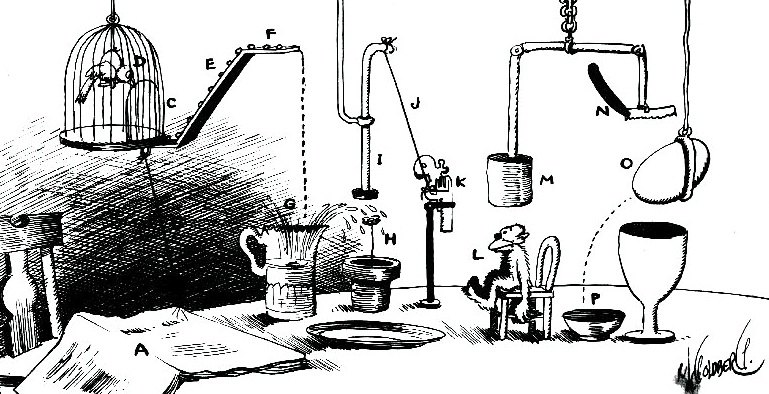THE GREAT RUBE GOLDBERG wasn’t an inventor, he was a cartoonist. The insanely clever, laughably complicated chain-of-events machines (string, J, fires pistol, K. Shot scares monkey, L, forcing razor, N, onto egg, O) that are forever linked to his name existed only his imagination and in his drawings.
A pity we can’t say the same for the inventors of wine accessories. Their inventions, which seem to become more implausibly complex and useless each year, are all-too real. They take the form of elaborately-designed aeration devices and extravagantly-engineered cork pullers (Peugeot has a nice one for $75; Le Creuset another for $249). Then there are the silly drip protectors, wine glass lanyards, and rare gas preservation systems . . . it goes on and on.

There are really only a few jobs that need to be done to open and serve wine and consequently only a handful of very simple tools needed to accomplish them. Here’s my short list of both.
1. A pretty tea towel. You need to tidy things up from time to time, mop a spill, wrap a chilled bottle. But mostly having a clean, pressed, nice-looking towel on hand adds a bit of color and panache to wine service. Also handy as backdrops for blog photos. Keep one within reach.
2. A roomy pitcher. Most wines benefit from a bit of aeration. Some get enough just by being poured into a glass, but for others a hard decant is called for. ‘Hard’ in this case just means you invert the bottle into a roomy pitcher and let it gurgle and splash its little heart out (see a more detailed treatment here). That’s it. As for the pitcher, all you really need is something clean that’s big enough to empty a whole 750ml bottle of wine into. Can be anything. The bright yellow pitcher you see above is all we’ve ever required.
3. A waiter’s corkscrew. To judge from the complicated machinery that’s been invented to draw a cork from a bottle, you’d conclude that the task is one calling for exceptional strength and sleights-of-hand known only to superannuated master sommeliers. So silly. Pulling a cork is a simple and straightforward job anyone can accomplish with a little practice and the elegant little tool known as the waiter’s corkscrew.

There’s nothing to it but a small blade to trim the capsule, a worm you insert into the cork, and a lever – in this case a double-jointed lever. It’s the second joint that lets you to re-position the lever on the lip of the bottle so that you don’t have to drive the drive the worm deeper for the second pull that extracts the cork. Need a lesson? See me at the Formaggio Kitchen tasting table for a quick show and tell.
4. DropStops. For a dripless pour, this simple little tool is unrivaled. Roll one of these flexible, Mylar-coated disks into a tube and insert it into the top of a bottle and you’re done. When placed well down in to the neck (as in photos below) it’s completely unobtrusive. Chances are good your guests won’t even notice what you’ve done unless you feel compelled to point it out. They’re inexpensive and each lasts years. I’ve never worn one out.
5. A Vacu-Vin. To make wine last, draw the air from the bottle. The white pump and gray rubber stopper at the top of the post comprise the Wine Saver from VacuVin. The stopper replaces the cork in a partially empty bottle; the little pump draws the air out of the headspace and makes a tight seal in a few strokes. A clicking sound tells you when you’ve got a vacuum. Will keep wine fresh for days or weeks if left sealed. When repeatedly opened and re-sealed it’s less effective, of course. Works with sparkling wine ,too – no matter what the website says. Widely available for around $15 with 2 stoppers.
6. A funnel. A smallish stainless steel funnel has more uses than you imagine – including making a clean transfer of wine from a pitcher-decanter back into the bottle, moving wine from a 750ml to a 375ml bottle, and (with a scrap of cheesecloth) helping filter debris from a schmutzig old wine.
I don’t think Rube ever designed a corkscrew, but if he had you can be sure there would be fewer unemployed monkeys in the world.

